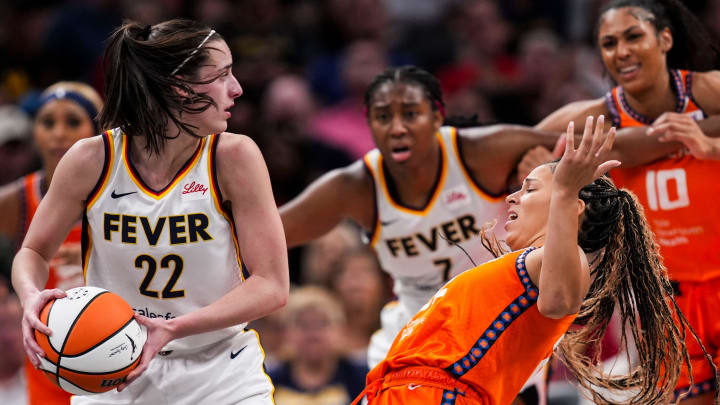SI:AM | Caitlin Clark and the Fever Are Surging at the Right Time

Good morning, I’m Dan Gartland. My alma mater’s football season got off to the worst start imaginable.
In today’s SI:AM:
⚾ MLB roundtable
🏊 USA Swimming shakeup
🏈 The NFL’s best skill position groups
Who saw this coming?
If you haven’t been paying close attention to the WNBA season, now is the time to start. The league returned from its Olympic break two weeks ago and with just three weeks left in the regular season, the playoff picture is beginning to take shape. Three teams—the New York Liberty, Minnesota Lynx and Connecticut Sun—have already clinched playoff berths, but it’s what’s happening in the middle of the standings that’s really interesting.
After getting off to a dismal start to the season, the Indiana Fever are suddenly among the hottest teams in the league and well on their way to clinching a playoff spot that seemed impossible after the season’s first month.
The Fever started the season 3–10, the second-worst record in the league over that span, but have really turned things around since then. Since June 13, they’re 12–6, fourth-best in the league. That recent hot streak (which includes a 4–1 record after the Olympic break) has been enough to vault the Fever from 11th in the league to seventh. It isn’t an enormous leap, but in a league where the top eight teams make the postseason it’s significant. And the Fever currently have a 4.5-game lead on the ninth-place Atlanta Dream with nine games to play, so they’re in good shape to make the playoffs.
So what’s gone differently for the Fever of late? Unsurprisingly, star rookie Caitlin Clark has elevated her game, and it’s paying dividends. In the team’s first 13 games, Clark averaged 16.3 points, 6.0 assists and 4.9 rebounds per game—a really solid start to her professional career. In fact, she was the only player in the WNBA with 200 points, 70 assists and 60 rebounds during that span. But she’s been even better of late. In Indiana’s last 18 games (since June 13), she’s averaging 19.2 points, 9.7 assists and 6.3 rebounds per game. Her shooting percentage has soared from .373 in the first 13 games to .440 since. Since June 13, she’s the only player in the WNBA with at least 200 points, 100 assists and 100 rebounds. (She has 346 points, 174 assists and 114 rebounds.) She now leads the league with 8.1 assists per game and is 10th in scoring with 18.0 points per game. Remember that supposed Rookie of the Year race with Angel Reese? It’s basically over.
Clark isn’t solely responsible for the turnaround, of course. Teammates Aliyah Boston and Kelsey Mitchell have also stepped up. Boston averaged 10.6 points and 7.0 rebounds per game on .420 shooting in the first 13 games of the year but is putting up 16.1 points and 10.7 rebounds per game on .572 shooting since. Mitchell averaged 14.7 points per game with a .384 shooting percentage (.329 from three) in the first 13 games but is up to 20.9 points per game on .498 shooting (.407 from three) since.
1,000 career points for Aliyah Boston 🤩👏 https://t.co/grsx7e3wf7 pic.twitter.com/B8LjF73yOd
— Indiana Fever (@IndianaFever) August 28, 2024
The Fever are really firing on all cylinders, though. Since June 13, they have the highest shooting percentage of any team in the WNBA (.470) after ranking fifth-worst in the league during their slow start (.416). Equally impressive, though, is their defensive 180. Indiana had the worst opponents’ field goal percentage in the league pre-June 13, and by a wide margin. The Fever’s .465 opponents’ field goal percentage was 19 percentage points worse than what the Washington Mystics were allowing. Since then, though, opponents are shooting just .426, virtually tied with the Dream for second-best in the league. (Atlanta’s opponent field goal percentage is .00046% lower.)
The Fever were never expected to be instant championship contenders after adding Clark. Teams that land the top pick in the draft are usually bad enough that one player can’t fix all their problems. But their recent hot streak has turned another lost season into a stepping stone toward bigger things, at the very least giving the players an opportunity to earn valuable postseason experience as they set their sights higher next season.
The question now is how much postseason experience they’ll earn. The WNBA’s playoff format puts lower seeds at a significant disadvantage. The first round is a best-of-three series with the first two games played at the home arena of the higher seed. The lower seed only gets a home game if it forces a decisive third game. At 15–16, the Fever are comfortably in playoff position, but that’s only good enough for the No. 7 seed. It seems like a longshot that they’ll be able to rise all the way up to the fourth seed and earn home-court advantage in the first round. They’re currently 4.5 games behind the fourth-place Seattle Storm. But even if the Fever draw one of the juggernauts at the top of the standings and make a quick playoff exit, their impressive run over the past two months has shown that they’re going to be a force to be reckoned with very soon.
The best of Sports Illustrated
- Our MLB experts got together to preview the final month of the season.
- USA Swimming is making major changes after a so-so showing at the Paris Olympics, Pat Forde reports.
- Matt Verderame ranked all 32 NFL teams’ skill position groups.
- Kyle Koster spoke with Dianna Russini, The Athletic’s NFL insider, about the ultracompetitive world of football newsbreaking.
- Blue Jackets forward Johnny Gaudreau died after being struck by a suspected drunk driver while riding a bike.
- Carlos Alcaraz was shockingly eliminated from the U.S. Open in the second round.
The top five…
… moments in college football last night:
5. Bowling Green’s touchdown return on the opening kickoff.
4. Missouri defensive back Toriano Pride Jr.’s leaping catch for a pick six.
3. Arkansas running back Ja'Quinden Jackson waving to the Arkansas-Pine Bluff cheerleaders after scoring a 46-yard touchdown.
2. Jordan Waters’s persistence on this touchdown run in NC State’s closer-than-expected win over Western Carolina.
1. Travis Hunter’s absurd touchdown catch, his third of the night.
